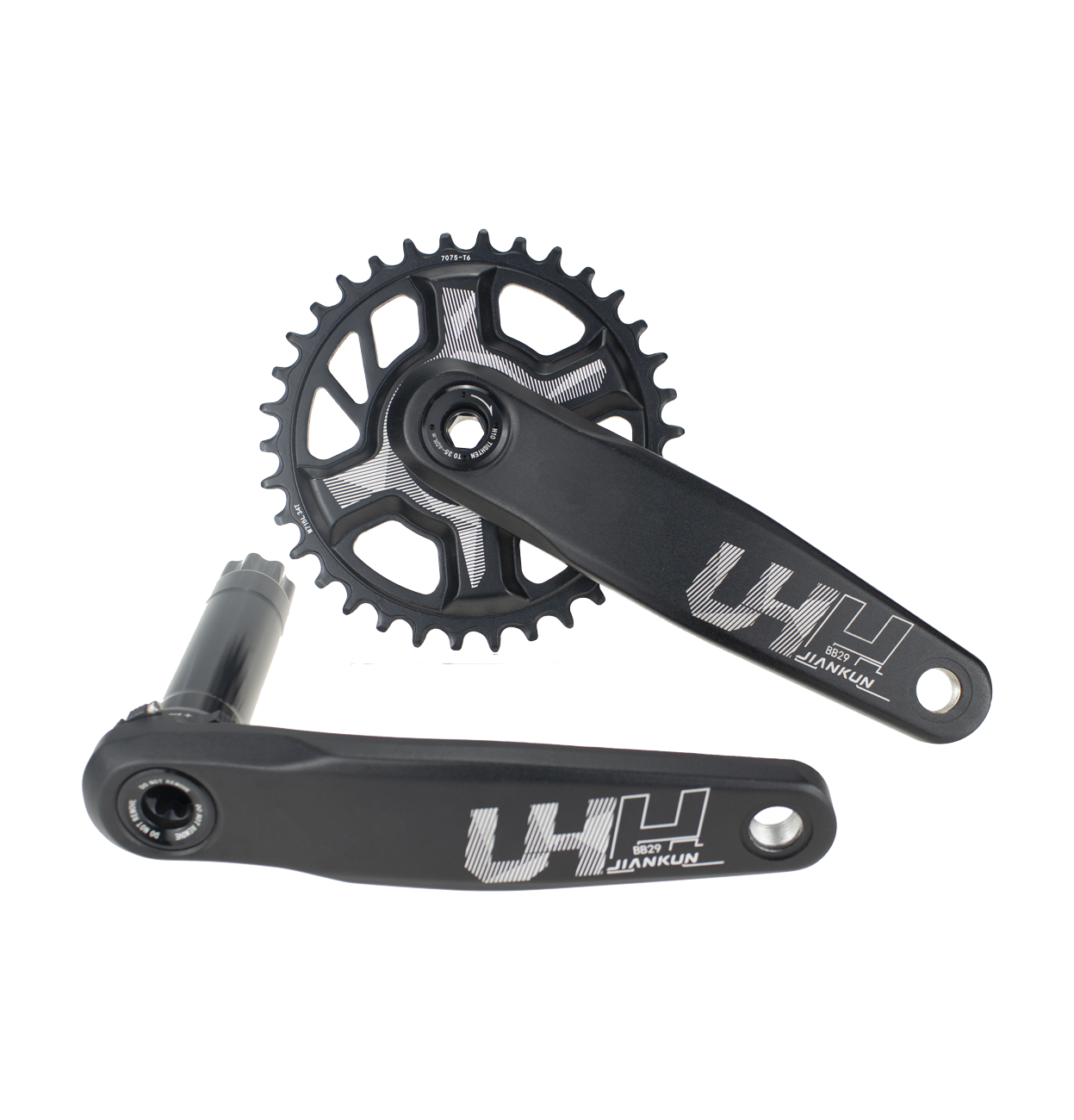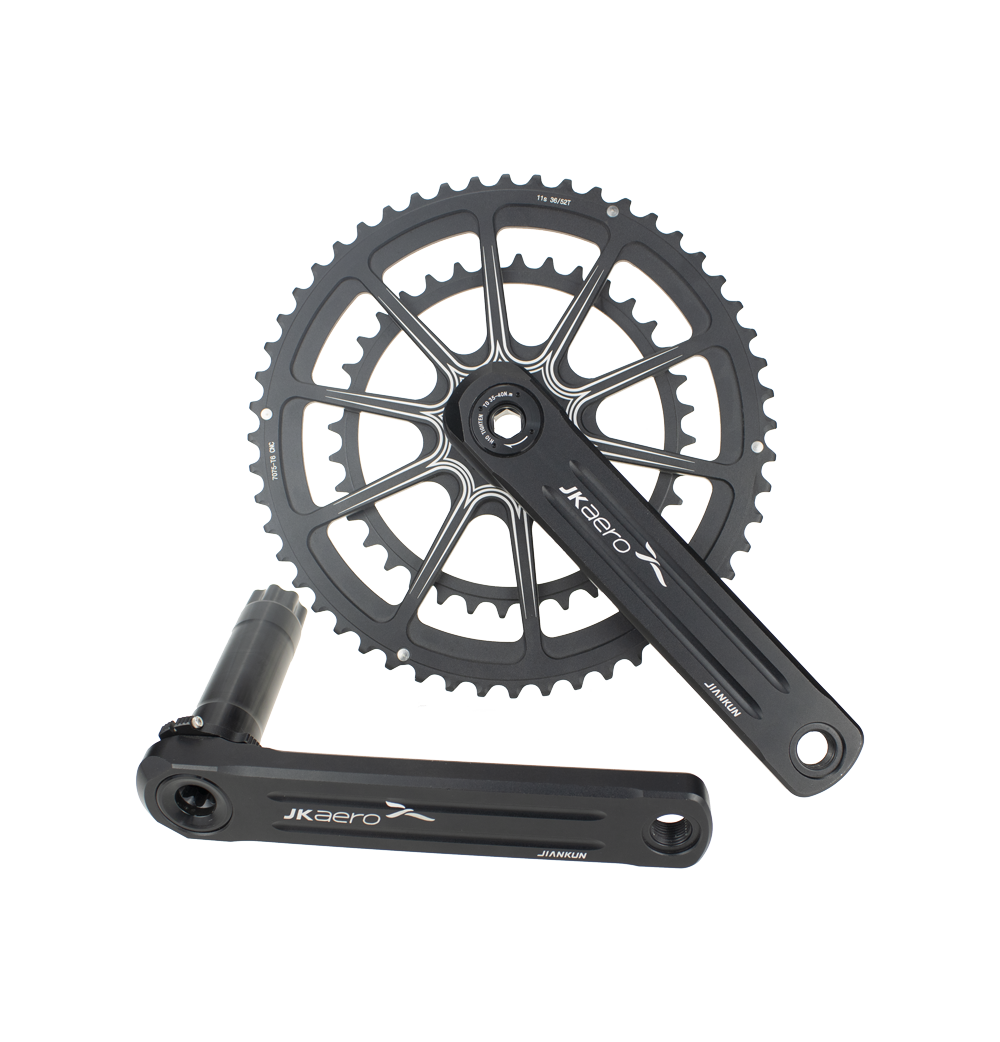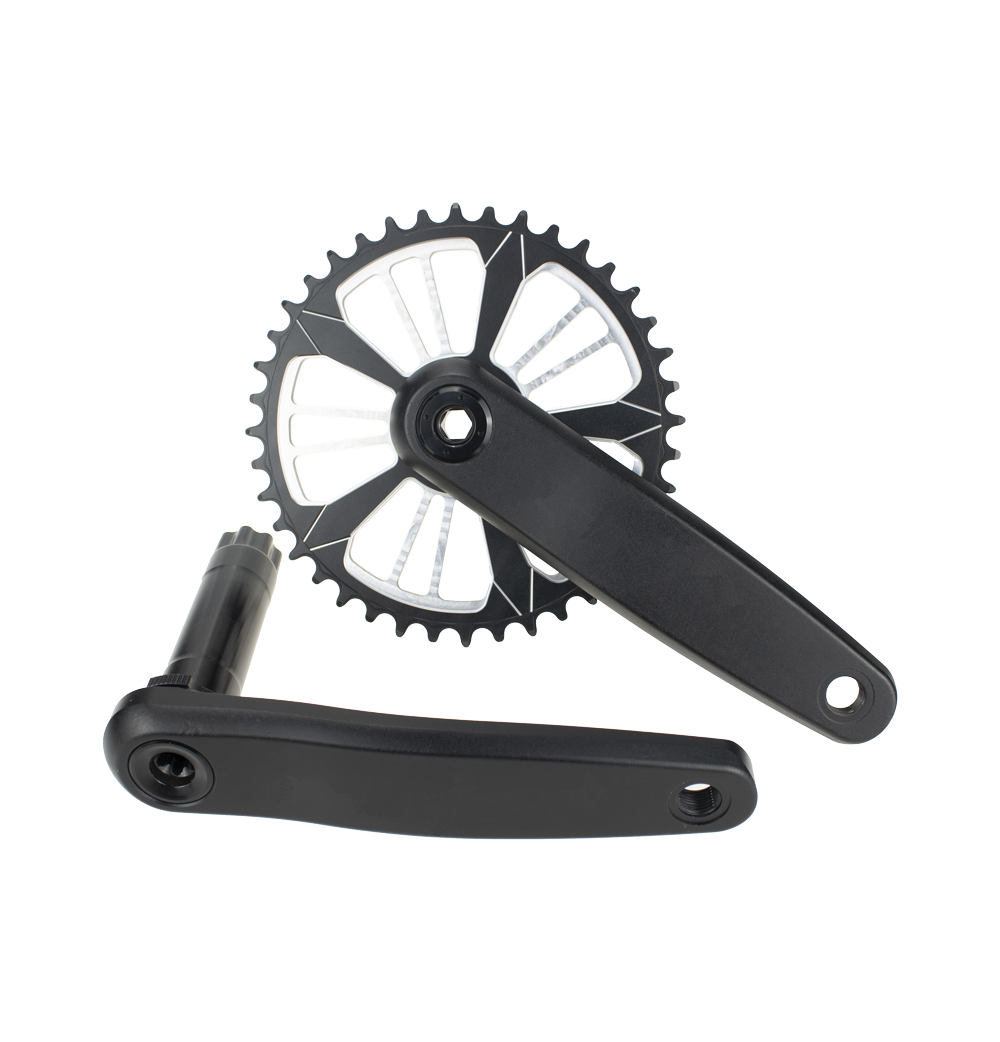Pyörän pedaalikorin toimipinta
Ymmärrys pyörän pedaalikopin perusteista
Pyörän pedaalikoppi on keskeinen osa, joka muuttaa ajajan pedaalisuorituksen pyörimiseksi voimaksi, mikä sitten ohjaa pyörän ketjun ja siten takapyörän. Se toimii vallittajajärjestelmän sydämessä, käännyttäen jalkavalmuutta pyörän liikkeeksi. Kopin pääosat sisältävät pedaaliharjoja, ketjusarjoja ja usein pohja-asterion. Jokainen näistä elementeistä on avainasemassa tämän muunnosprosessin tehokkuuden varmistamisessa.
Yleensä pedaliin kuuluu pedalkivet, jotka toimivat levynä, erisuuruiset ketjusarakkeet, jotka määrittävät vaihteistoja, sekä akseli, joka yhdistää kaiken pyörän kehystään. Nämä osat toimivat yhdessä varmistaakseen sileän ja tehokkaan voimansiirron. Hyvin suunniteltu ja laadukas pedali parantaa tätä tehokkuutta, mikä johtaa parempaan yleiseen pyöräilysuoriin. Pitempien nousujen tai tasaisempien reittien kulkemisessa pedalin laatu merkittävästi vaikuttaa ajajan kokemukseen optimoimalla voimansiirtoa, mikä on tärkeää sekä kilpailullisille että harrastajapyöräilijöille.
Tärkeimmät osatekijät
- Moottorinkäsia : Nämä muuttavat pedaalauksia pyöriväksi voimaksi.
- Ketjusarakkeet : Nämä vaihtelevat kokona ja ovat ratkaisevia erilaisten ajomuotojen sopeuttamiseksi.
- Alareunapyörä : Usein mukana, yhdistää pedalin pyörään helpottaa pyörityksiä.
Tehokas voimansiirto ei ainoastaan paranna suorituskykyä, vaan se myös mahdollistaa pidemmät ajot vähemmällä väsymyksellä, mikä korostaa investoidun laadukkaaseen pedalointiin merkitystä.
Pyörän pedaalikorin keskeiset osat
Pyörän pedaalikarvat ovat keskeisiä komponentteja, jotka yhdistävät pedaalit pedaalikoriin. Ne toimivat levynä, jotka helpottavat tehokasta voiman siirtymistä pedaalin aikana. Muuntaen pyöräilijän jalkavoiman pyörimisenergiaksi, pedaalikarvat pelaa tärkeän roolin pyörän kokonaispropulsioon. Pedaalikarvojen pituus vaihtelee yleensä 170mm:n ja 175mm:n välillä, mikä on sopeutettu pyöräilijän pituuteen ja pyöräilytyyliin. Modernit pedaalikarvat tehdään usein kevyestä materiaalista, kuten hiilikuitusta tai alumiinia, tarjoamalla tasapainoa vahvuuden ja painon välillä.
Vaihteet, toinen keskeinen osa pyörän väännössä, ovat hampaita, jotka vaikuttavat pyörän ketjun käyttämään väännöksiin. Ne saatavat eri kokoja, mikä antaa ajajille mahdollisuuden säätää vähennysasteitaan riippuen heidän ajomuodostaan ja maastoon. Pienemmät vaihteet ovat ideaalisia nousuille, koska ne tarjoavat alempia vähennysasteita, kun taas suuremmat vaihteet hyödyttävät sprinttereitä korkeammilla nopeuksilla tasaisella maastolla. Oikean kokoinen vaihteiden valinta vaikuttaa merkittävästi ajajan nousukykyyn ja huipputulokseen.
Pyörä, toimien krankijonon sydänä, toimii keskipisteenä, jossa voima siirtyy krankisista pyörän vallikkeeseen. Se yhdistää krankijonon molemmat puolet alapohjassa, varmistamalla sileän pedaalin liikkeen. Pyörän teknologia on kehittynyt huomattavasti, ja materiaaleja käytetään alimmiltaan terästä edistyksellisiin alumiineihin ja chromolyyn, mikä mahdollistaa paremman kestovuoren ja painon säästöjen. Säännöllinen pyörän huolto varmistaa optimaalisen voiman siirtämisen ja estää melun ja tehokkuuden heikkenemisen pyöräilymassassa.
Pyörän kettuparien tyypit
Polkupyörät vaihtelevat suuresti, ja niiden pedaalikaset myös. Jokainen tyyppi on erityisesti suunniteltu vastaamaan erilaisten ajomuotojen vaatimuksia. Maantien polkupyörän pedaalikaset ovat rakennettu kestävyyden varmistamiseksi, ja ne sisältävät vahvoja suunnittelemuksia, jotka kestää maantien pyöräilyn vaativat ehdot. Ne sisältävät usein leveämpiä pedaalikäsioita ja ovat suunniteltuja selviytymään voimakkaita maastopyöräilyn ja hyppyjen voimia. Kestävyyden painottaminen tarkoittaa, että ne ovat yleensä painoisempia, mutta ne takaisivat vakauden ja pitkäjänteisen suorituskyvyn haastavilla reiteillä.
Talven pyörän pedaalikaset on optimoitu nopeuteen ja tehokkuuteen tasaisilla, kiinteällä pinnalla. Nämä pedaalikaset ovat yleensä kevyempitä ja suunniteltuja kapeammilla pedaalikäsioilla parantaakseen aerodynamiikkaa. Ne tarjoavat myös sileät hiihtosuhdeluvut, mahdollistavat tehokkaan pedaalinpyörimisen ja säilyttäävät liikkeen. Erityinen suunnittelu pyrkii vähentämään painoa ja parantamaan suorituskykyä, mikä tekee niistä suosittuneeksi valintaksi kilpailullisille pyöräilijöille, jotka keskittyvät nopeuteen.
Kiinteä vaihteisto, jota usein valitsevat kaupunkipyöräilijät, korostaa yksinkertaisuutta ja tehokkuutta. Se toimii vain yhdellä vauhdilla, mikä mahdollistaa suoran voimansiirron ja vähentää mekaanisia menetyksiä. Tämä yksinkertaisuus tarkoittaa myös alhaisempia huoltotarpeita, koska komponentteja on vähemmän murremaan tai hajottumaan. Siksi ne ovat suosittuja kommunikoiden keskuudessa, jotka etsivät luotettavaa suorituskykyä ja helpoa huoltoa.
Oikean pyörän käyräkiven valitseminen
Oikean pyörän pedeliryhmän valitseminen on keskeistä parantaaksesi pyöräilukokemustasi, koska siihen vaikuttaa useita tekijöitä, kuten pyöräilyn tyyli ja ajajan suosituksia. Olipa sinulla sitten teiden pyöräilyä, metsäpyöräilyä tai kaupunginmatkustusta, pedeliryhmä on tärkeä osa suorituskyvyn kehittämistä. Esimerkiksi teiden pyöräilijät saattavat suosia pedeliryhmiä, jotka tarjoavat korkean nopeuden tehokkuutta, kun taas metsäpyöräilijät arvostavat vahvasti suunniteltuja järjestelmiä kestääkseen maanteilliset olosuhteet. Kaupunkimatkustajat etsivät usein yksinkertaisuutta ja luotettavuutta, mikä tekee siitä välttämättömänä sovitella pedeliryhmä omiin pyöräilytyyliisi ja henkilökohtaisiin suosikkiohimmeksesi.
Kynsien pituuksien ja kokojen ymmärtäminen on keskeistä ajajalle sekä mukavuuden että pedaalin tehokkuuden kannalta. Kynsien pituus vaikuttaa merkittävästi pedaalin dynamiikkaan; pidemmät kynsät voivat lisätä levitystä, mutta ne saattavat aiheuttaa epämiellyttävyyksiä, jos ne eivät sovi polvien pituuteen. Tyyppisesti kynsien pituudet vaihtelevat 165mm:n ja 180mm:n välillä, ja sopivan koon valitseminen voi optimoida mukavuuden ja tehokkuuden sopeutumalla kehon mekaniikkaan, mikä helpottaa paineita ajossa ja parantaa pedaalin voimaa.
Yhteensopivuus on toinen keskeinen tekijä, kun valitset pedaaliksiinon, koska eri pyörät vaativat tiettyjä konfiguraatioita kehyksen suunnitelman ja alapinnan tyypin perusteella. Jokaisen pyörän kehys ja alapinta edellyttävät pedaaliksiintä, joka sovittelee täydellisesti välttääkseen mekaanisia ongelmia ja varmistaakseen tehokkaan voimansiirron. Tekijöitä, kuten akselijohdon tyyppi (neliömukkainen, octalink tai press-fit) ja suunniteltu vaihteisto, on sovitettava pedaaliksiinon kanssa, jotta pyörä toimii sileästi ilman yhteensopivuusongelmia. Nämä tekijät ottaen huomioon voit mukauttaa pedaaliksiinon valintasi niin, että se sopii täydellisesti pyöräsi rakenteeseen ja parantaa kokonaisvaltaista käyntikokemustasi.
Suorituskyvyn parantaminen pedaaliksiinon päivityksillä
Pedaaliksiinon päivitys voi merkittävästi parantaa pyöräsi suorituskykyä, erityisesti korkean suorituskyvyn komponenteilla, kuten U4-715L-9D Maantienpyöräilyyn tarkoitetut pedeliryhmät. Nämä pedeliryhmät tarjoavat nopeita väringsvaihtotoimintoja, jotka ovat keskeisiä maantienpyöräilyyn. Ne sisältävät monipuolisia ketjusarvi vaihtoehtoja ja varmistavat sujuvat väringsvaihdot, optimoimalla ajokokemuksesi haastavilla reiteillä.

Tielippujen pyöräilyyn premiumluokan pedeliryhmä kuten CXVA-72AK-9D tarjoaa tarkkoja siirtoja, mikä on olennaista pitkien matkojen tehokkuuden ylläpitämiseksi. Niitä tehdään korkealaatuisesta alumiinimestä, ja ne toimittavat sujuvia väringsvaihtoja ja optimaalisen voiman siirtymisen, varmistaen että ajo on sekä dynaaminen että luotettava.

Gravelajoon pedeliryhmä kuten JKB-714L-9D kevyt hiilikuituvenyt käyräjoukot ovat suorituskyvyn kannalta erinomaisia. Ne on suunniteltu tarjoamaan vakautta ja luotettavaa voimansiirtoa, mikä tekee niistä täydellisiä pitkien matkojen ja erilaisen maastoon kohtaamiseen, varmistamalla että säilytät etunsa haastavissa olosuhteissa.

Johtopäätös: Käyräjoukkojen vaikutus pyöräilyn kokemukseen
Pyöräilyn tehokkuuden ja mukavuuden parantamisessa kruunijoukot pelaa keskeisen roolin. Hyvin valittu kruunijoukko varmistaa, että pyöräilijä voi maksimoida voimantuotonsa ja ylläpitää sujuvan ja tehokkaan pedaalinvauhtia, mikä nostaa huomattavasti kokonaispyöräilijakokemusta. Kruunijoukon valinta vaikuttaa kaikkiin asioihin, alkaen nopeudesta ja päättyen nousukykyyn, mikä tekee siitä olennaisen komponentin jokaiselle pyöräilijälle. Parhaan kruunijoukon valitseminen henkilökohtaisiin pyöräilytarpeisiin ja tavoitteisiin sopeutettuna on ratkaisevaa. Ymmärtämällä omat tarpeensa pyöräilijät voivat varmistaa, että heillä on täydellinen asetus, mikä johtaa parempaan suorituskykyyn ja miellyttävempään ajoon.

